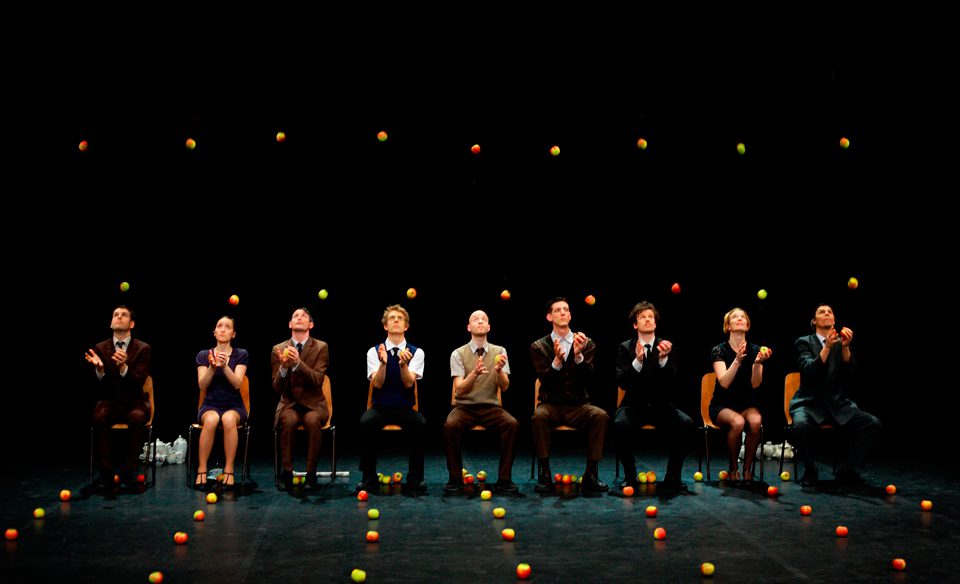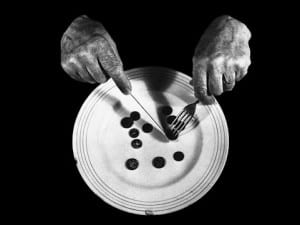Sean Gandini brings a unique approach to juggling with Smashed, a homage to Pina Bausch and the mathematics of dance, featuring four crockery sets, nine performers and 80 apples.
Two art forms not often paired in the same sentence are ballet and juggling. They occupy very different spheres culturally, socially and historically. Juggling finds a space in street performance, circus shows and vaudeville or variety, whereas ballet is the place of wealthy patrons, swooping ceilings and full orchestras. Despite this though, there is plenty to connect them, and Gandini Juggling has spent the past 22 years exploring the possibilities of what this performance art can be, reinventing the form and helping to lead the vanguard in the changing perception of the skills involved.
Sean Gandini describes his interest in juggling as coming from a love of painting and of mathematics: “Initially I became addicted to the physical sensation and the geometric patterns that you can make. I think there’s something about moving geometry that appeals to my mathematical addictive mind.” It’s this link that connects the form with ballet and dance too: both dance and juggling create transient visual images. Gandini terms them as “ephemeral architectures – structures that don’t last very long because they move into space and then they disappear.” They are made different by the fact that the pictures in dance are often created solely by the movement of the body, but in juggling they are created by external components which only exist from moving the body.
Gandini is keen to mention another difference. He says: “The other thing is the dropping. The chances of a dancer falling over or tripping are much smaller than the likelihood of a juggler dropping, which is a big, extra, complicated thing.” This accidental feature of juggling is fascinating. A recent stint at the newly re-launched National Centre for Circus Arts (formerly Circus Space) in London revealed juggling to be an art that’s accompanied by a surprising amount of philosophy and thought. Part of this includes knowing dropping is inevitable. You will drop the ball. So you have to just focus your concern on throwing the ball. It’s incredibly simple; one can only progress through dropping because it both implies and demonstrates that a risk has been taken. It seems almost like a maxim for life.
There’s also a rhythm and pattern that mimics dance: juggling is co-ordinated and there is a choreography to the art. The show Smashed is a perfect example of the various ways the two forms can exist together: while Gandini’s upcoming 2015 show 4×4 brings the Royal Ballet and jugglers together, their piece Smashed channels the work of modern dance legend Pina Bausch (1940-2009). Gandini remarks: “Anyone working in contemporary theatre or dance has a debt to pay Bausch. When we made Smashed it was a bit of an homage; we didn’t expect the piece to stay and perhaps it is the strength of her influence that has made this show so popular.”
Featuring 80 apples, nine jugglers and four crockery sets, the production is a stunning exploration of conflict and relationships alongside incredible technical skill. The apple is a symbolic choice as well as a physical one: originally selected as a prop for a different show about Newton, it represents not only the understanding of gravity (something that is essential to juggling) but also the forbidden fruit, the temptation in the Garden of Eden. From there it is not too small a leap to ideas of gender positioning in society and male-female relationships historically and socially.
Gender interactions and relationships were important to Pina Bausch so the way her work and ideas have influenced the piece can be seen throughout various aspects of the productions from the choreography through to the costumes. There are Bauschian elements in both the themes and in the execution of them: “There’s a Bauschian parade, which is very simple steps with the lovely choreography that she used to put on top; I had always wondered if it would work with juggling. The costume is very appropriate and of a certain period too – men in suits and women in dresses.”
The relationship between the men and the women in the show is layered: “There’s an element of cruelty which has sometimes been a little controversial. The first two or three pieces in the show are a bit vaudevillian and the first time that the men are real bastards it comes as a bit of a shock. One is reading it as a variety show so one isn’t expecting that kind of thing.” The men attempt to get attention from the women and disturb their juggling whilst the women flirt with the men until they drop their props. Despite the perceived malice in their intentions, Gandini reminds us that in its simplest form it is a display of skill: “It’s something we never really addressed before: juggling as a power play or as a form of seduction.” Everyone is showing off and competing against each other, but also themselves.
It seems that it is no longer sufficient just to demonstrate skill with your art though: since the dawn of televised performance audiences expect more from their performers. However, Gandini suggests that it’s not the audience that has changed, but simply the variety of choice. “When we started there were one or two other people globally trying to do alternative things. Maybe one of the biggest differences was that juggling 25 years ago was a seven-minute act. I think what contemporary circus has done is show that it can be entertainment for a whole evening. That’s certainly changed.” He points out that the more venues programme this type of performance, the more likely audiences are to appreciate it. Art forms that are living on the periphery never attract the same attention from the viewing public.
Circus has certainly found a growing support in the UK over the past few years and slowly even the funding bodies are beginning to recognise it as a valuable contribution to the cultural sphere, although there are still challenges. From the Roundhouse’s recent Circusfest to the Udderbelly Festival at the Southbank Centre, circus is very much alive and well in the UK and with the former Circus Space acquiring National Centre status it looks set to develop even further over the coming years. In addition to Smashed, the wild circus show, Limbo, also returns to the Southbank Centre this summer. Limbo is a vibrant carnival of contortion, aerial acrobatics and illusions set to a thrilling score of brass, electronics, hip-hop and club beats, made all the more enjoyable by its setting in the stunning German Spiegeltent.
These kind of mash-up collaborations between different genres and cultures of dance, music, circus and vaudeville make it a very exciting time for the circus arts in the UK. This summer there will be plenty of opportunity to reconsider preconceived ideas of traditional street performance and to explore, along with Gandini, where juggling could go next. Smashed is part of the Udderbelly Festival at the Southbank Centre. It runs from 22April until 18 May. Limbo will run from 7 May until 17 August at London Wonderground, another collaboration between Underbelly and Southbank Centre, situated between the Royal Festival Hall and the London Eye. London Wonderground is part of Southbank Centre’s Festival of Love this summer from 30 May – 7 September. Hundreds of artists, communities and partners will participate in creating a festival that will explore the many different facets of human love, from romantic love and the breakdown of relationships, to the harmony (or disharmony) between nations and the concept of memorias. The festival will feature a wide-ranging and stunning programme of themed weekends, performances, talks, outdoor art installations and urban greenery across the site, with one of the highlights being Proud To Be Wed, a mass wedding event for gay and straight couples. Visit www.underbelly.co.uk or www.southbankcentre.co.uk for more information and tickets.
Bryony Byrne





